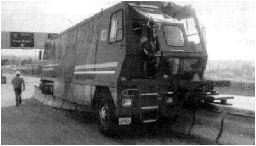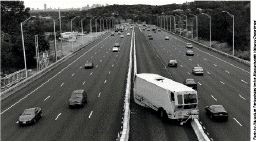


| -------- -------- & Specials -------- |

©1996-2001 |
|
-----
Contraflow to the next level

Please click on the images to load a larger view
note: article was written before Zipper Lane opened
I apologize for the inconvenience of the missing images. I lost them due to an accident and I am in the process of recovering them. However, it may take some time. Please pardon the inconvenience.
"Honk!"
If you happen to commute to work from Leeward or Central Oahu during the morning rush hour, that sound is all too familiar. Everyone knows that there are too few lanes on the H-1 to hold all the cars that travel upon it each morning. But look across the divider. Almost no one is going the other direction. Why are those lane so underutilized? The State Department of Transportation has a plan to change all that.
With no plans for any new highway systems on Oahu the DOT plans to implement a new type of contraflow lane in the fall of this year called the 'Zipper Lane'. The new lane, which utilizes a Zipper machine, will be placed between the Managers Drive Overpass and the Pearl Harbor Interchange. When in use, one lane from the westbound direction will be made available to high occupancy, Honolulu-bound vehicles.
 How does this marvelous machine work? As the name says, just like a zipper. The Zipper machine, as it travels west will move a string of connected concrete barriers (see picture) from their storage position in the median to their Zipper Lane position. The corridor created by the movable barriers will add a full traffic lane as well as a shoulder area. HOV vehicles will be able to pull over in the shoulder without interfering with traffic in the contraflow lane and emergency vehicles will also be able to use the lane and/or the shoulder.
How does this marvelous machine work? As the name says, just like a zipper. The Zipper machine, as it travels west will move a string of connected concrete barriers (see picture) from their storage position in the median to their Zipper Lane position. The corridor created by the movable barriers will add a full traffic lane as well as a shoulder area. HOV vehicles will be able to pull over in the shoulder without interfering with traffic in the contraflow lane and emergency vehicles will also be able to use the lane and/or the shoulder.
Now don't get too excited yet, the Zipper Lane may not be for you. The new contraflow lane will be for buses, vanpools, and carpools with 3 or more occupants ONLY. If you have two people in your vehicle, you will still be allowed to use the existing HOV lane, but just not the Zipper Lane. The lane will be opened at 5:30 each morning and closed again at 9:00 am, after which the Zipper Machine will move the barriers back to their original position along the median, returning the freeway to its normal lane configuration.
 Wow! Hawaii gets to be one of the first states to use this new and exciting type of contraflow lane. Well, not exactly. Contraflow systems using moveable barriers such as this have been successfully implemented in many metropolitan areas across the United States, including Boston (see picture), Dallas, Sand Diego, and New York City. And all of these locations have reported greatly improved traffic flow during rush hour and an increased number of people carpooling and ridesharing.
Wow! Hawaii gets to be one of the first states to use this new and exciting type of contraflow lane. Well, not exactly. Contraflow systems using moveable barriers such as this have been successfully implemented in many metropolitan areas across the United States, including Boston (see picture), Dallas, Sand Diego, and New York City. And all of these locations have reported greatly improved traffic flow during rush hour and an increased number of people carpooling and ridesharing.
Continue along the Zipper Lane